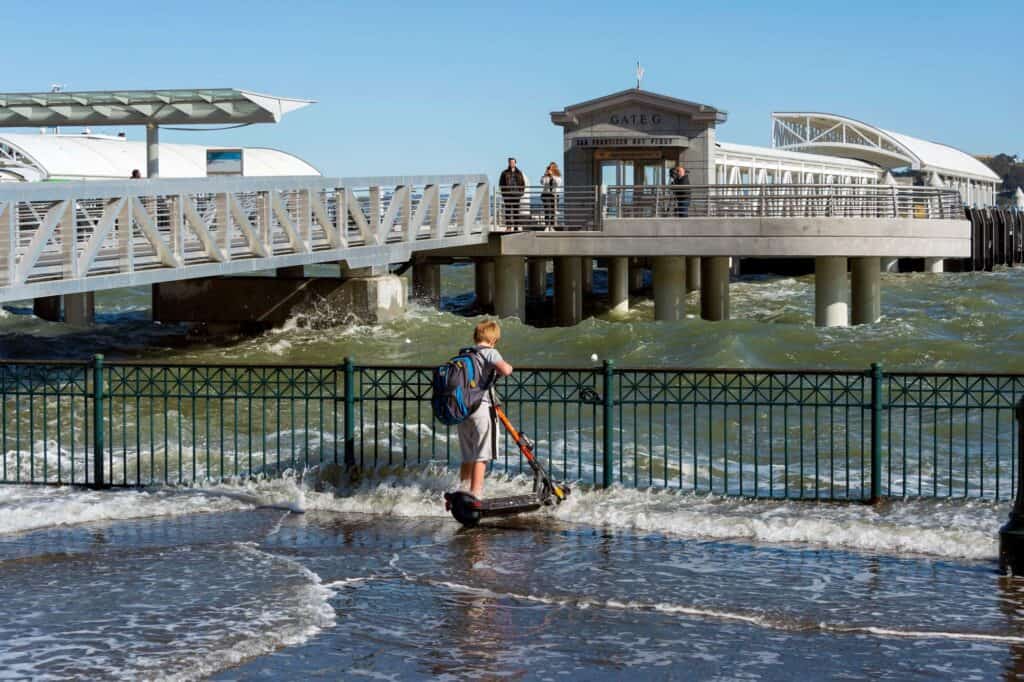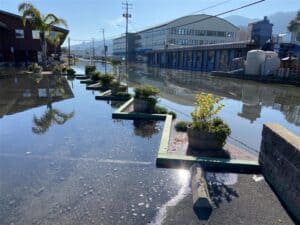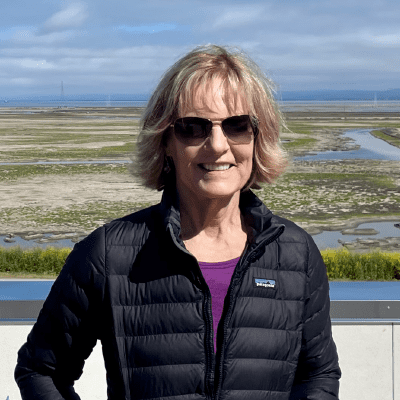
Sea level rise is one of the most daunting effects of a changing climate, especially in the Bay Area. As average temperatures rise across the globe, it is becoming clearer how sea level rise will impact our communities. Flooding, groundwater intrusion, and extreme storms are predicted to increase in the coming decades, leading to displacement and adverse health impacts in Bay communities – particularly in cities with few resources and little protective infrastructure. An estimated 350 thousand residents in the Bay Area currently live in the flood zone and around $46 billion in economic assets are under threat.1 To properly protect the Bay Area from the impacts of sea level rise, the Bay Conservation and Development Commission estimates that it will cost $110 billion over the coming decades.2
Save The Bay’s policy team has been working to protect communities from the impacts of rising sea levels in the Bay through advocacy for nature-based solutions and policy improvements that shift how our region builds with climate impacts in mind. It is important for all people living in the Bay Area to stay informed about the future we face, and the actions taken by the government to mitigate these risks.


So, what is the state of California doing to protect our region from the impacts of sea level rise?
In 2004, in response to scientific research revealing that the state’s coastal regions were severely threatened, the State of California passed the California Ocean Protection Act which created the Ocean Protection Council (OPC).3 With these initiatives, California aims to protect its coast through science-based policy and management.
In 2018, the Ocean Protection Council released a detailed guide entitled “State of California Sea Level Rise Guidance” to inform cities and counties of the possible coming risks of sea level rise. The guide serves as a pertinent resource for state and local policy makers to include in their decision-making process by identifying the likely ranges for sea level rise impacts – Low, Intermediate, and High. These scenarios depend on actions taken now to reduce emissions and slow global warming. If nothing is done, higher range impacts are likely.4 This data is a framework for policymakers to implement evidence-based plans of action to mitigate the risk of sea level rise, and hopefully prevent the most harmful impacts.
In 2024, the Ocean Protection Council will release an updated version of the paper including significantly improved sea level projections and further state guidance based on the scientific evidence.5 A draft of the updated document was released in January.
The Updated Predictions

- Sea levels are predicted to rise between 0.5 – 1.2 ft by 2050, 1.0 – 6.6 ft by 2100, and 1.3 – 11.9 ft by 2150. A statewide average of 0.8 ft rise is most likely by 2050 (the Intermediate Scenario).5
- In general, areas of life impacted most likely are public infrastructure, private development, homes and businesses, public health and safety, and natural systems.5
- A rapid increase in storms, high tides, and El Nino events are predicted, starting in the 2030s. Scientists anticipate 20-30% loss of California’s beaches with no intervention. Further, significant loss of coastal wetlands and tidal marshes may occur.5
The document provides scientifically backed evidence for what many have been saying for decades: sea levels are rising, and the impacts our region will face vary significantly depending on how prepared we are to reduce emissions and implement effective mitigation strategies.
Your Support Matters
Save The Bay is working hard to ensure Bay Area communities are resilient to climate change. But we need donors like you to make our work possible. When you give, you directly support projects like our Sea Level Rise and Flood Resilience Strategy.
Save The Bay’s Sea Level Rise and Flood Strategy


In April 2023, Save The Bay published our own San Francisco Bay Sea Level Rise & Flood Resilience Strategy, a paper discussing our policy and project priorities for limiting the risk of sea level rise in our region. We discuss the importance of utilizing three key principles to properly protect vulnerable areas from the coming impacts of sea level rise and flooding:
Utilize nature whenever possible.6 The Bay Area should implement scientifically sound nature-based infrastructure like restored tidal marsh and horizontal levees on our shorelines to protect communities from rising tides. Not only do nature-based solutions effectively buffer our shorelines from incoming sea level rise, they also support thriving habitats and space for people to enjoy nature. Further, urban greening using stormwater infrastructure should be utilized in cities to mitigate flooding and decrease the impacts of warming from the urban heat island effect.
Center the voices of frontline communities.6 Lower income and disadvantaged communities in the Bay are more likely to be impacted by sea level rise and flooding and lack the resources to prepare. Centering these communities is important in properly equipping our region.
Build for flood resilience.6 It is important for development to be strategically placed in areas less vulnerable to flooding and nearby public transportation. In addition, new building standards should be implemented to require buildings in ill-protected areas to mitigate the risks of flooding.
To learn about our specific priorities for protecting and preparing the Bay, check out our San Francisco Bay Sea Level Rise & Flood Strategy. Read the draft of OPC’s State of California Sea Level Rise Guidance: 2024 Science and Policy Update.
Sources
- Ask An Expert: What Flood Risk Does the Bay Area Face?
- Adapting to Rising Tides – Sea Level Rise Adaptation Funding & Investment Framework
- Ocean Protection Council – About Us
- State of California Sea Level Rise Guidance – 2018
- State of California Sea Level Rise Guidance – 2024 Draft
- San Francisco Bay Sea Level Rise & Flood Resilience Strategy

















































